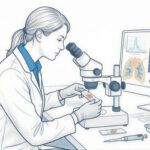Postmortem neurological checks play a crucial role in understanding the complexities of the human brain after death. These specialized examinations focus on the brain to identify conditions or abnormalities that might have been undiagnosed during a person’s life. The insights gained from these checks can be invaluable, not only for medical research but also for offering clarity and closure to families.
A brain-only autopsy involves a detailed examination of the brain tissue. This process can uncover neurological disorders, mental health conditions, or other issues that might have gone unnoticed. For families, knowing the exact neurological cause of death can resolve lingering questions and provide a deeper understanding of their loved one’s health.
Moreover, the information gleaned from postmortem neurological checks contributes to medical research. Researchers can study the findings to learn more about brain diseases, enhance diagnostic techniques, and develop better treatments.
This dual benefit highlights the importance of these checks in both personal and scientific contexts. Understanding the process, significance, and common discoveries can help families and medical professionals appreciate the value of postmortem neurological checks.
The Importance of Postmortem Neurological Checks
Postmortem neurological checks are vital for several reasons. They uncover the true cause of death related to brain conditions that may not have been diagnosed while the person was alive. By examining the brain, pathologists can identify diseases like Alzheimer’s, Parkinson’s, or other neurological disorders. Knowing these causes provides peace of mind to families and answers lingering questions about their loved one’s health.
These checks are essential in cases where the deceased displayed unexplained symptoms. Understanding the role neurodegenerative diseases played can help family members care for their own health, particularly if these conditions are hereditary. This information can guide them in seeking early intervention and preventive care.
Moreover, postmortem neurological checks support legal processes. In some circumstances, understanding the exact cause of death can be vital for legal clarity—whether for insurance claims, medical malpractice cases, or other legal matters. Having a detailed autopsy report ensures that the true cause of death is documented, helping families in their legal battles.
Techniques and Procedures for Brain-Only Autopsies
Brain-only autopsies focus exclusively on examining the brain. The procedure begins with a careful incision to access the brain. Once the skull is opened, the brain is removed for detailed examination. Pathologists then perform a series of steps to inspect the brain thoroughly.
The first step is a visual inspection to note any obvious abnormalities, such as tumors or physical injuries. Following this, the brain is sliced into sections to explore its inner structure. This cross-sectional analysis reveals conditions like hemorrhages, brain swelling, or signs of infection.
Specialized tools and techniques are employed for deeper inspection. Microscopic analysis examines brain cells for signs of disease, such as plaques associated with Alzheimer’s. In some cases, chemical tests analyze the brain tissue for toxic substances. These detailed examinations uncover minute abnormalities that contribute to understanding the individual’s health condition.
By using these meticulous techniques, brain-only autopsies provide a comprehensive view of neurological health, helping to identify hidden diseases and conditions that impact families and inform medical research.
Common Findings in Postmortem Neurological Examinations
Postmortem neurological examinations often reveal various conditions that contribute to a better understanding of the deceased’s health. One common finding is Alzheimer’s disease. Identified by the presence of amyloid plaques and neurofibrillary tangles in the brain tissue, this condition affects memory and cognition. Detecting Alzheimer’s postmortem confirms the diagnosis for families and underscores the genetic risk for relatives.
Another frequent discovery is cerebrovascular disease, which includes conditions like stroke and aneurysms. Evidence of a stroke might include brain tissue damage or signs of a blood clot. Identifying these conditions postmortem helps explain sudden deaths and can highlight potential risks for surviving family members.
Chronic traumatic encephalopathy (CTE) is another condition often found during neurological checks. Linked to repeated head injuries, CTE is common among athletes and military personnel. Examining the brain for signs of CTE, such as abnormal tau protein deposits, provides crucial information for understanding the impacts of repeated trauma on the brain.
These findings, among others, highlight the importance of detailed postmortem neurological examinations. They provide families with definitive answers and contribute valuable information to medical research.
How Neurological Checks Aid Families and Medical Research
Postmortem neurological checks offer significant benefits to both families and medical research. For families, these examinations provide clarity about their loved one’s cause of death. Understanding whether neurological conditions played a role can bring emotional relief and closure. In hereditary cases, it alerts surviving family members to potential risks, prompting early interventions and preventive measures.
For example, if an examination reveals a hereditary brain disorder, family members can seek medical advice, undergo screening, and make lifestyle changes to manage their health better. This proactive approach can reduce the risk of developing similar conditions.
From a research perspective, postmortem neurological examinations advance scientific knowledge. The detailed findings contribute to studies on brain diseases, improving our understanding of conditions like Alzheimer’s, Parkinson’s, and CTE. Researchers use this data to develop better diagnostic tools, treatments, and prevention strategies.
These checks also support the development of personalized medicine. By understanding the specifics of brain conditions and their impacts, researchers can tailor treatments to individual needs. This level of detail enhances the efficacy of medical interventions, leading to better health outcomes.
Conclusion
Postmortem neurological checks play an essential role in understanding brain health and aiding both families and scientific communities. These examinations uncover vital information about neurological conditions, providing clarity and answers that help families cope with loss. They also highlight potential health risks for surviving relatives, allowing for proactive measures to safeguard their well-being.
Additionally, the findings from neurological checks advance medical research. By contributing to studies on brain diseases, they enhance our understanding and improve the development of diagnostic and treatment methods. The insights gained from these examinations drive progress in medicine, ultimately benefiting future patients.
If you need a brain-only autopsy to understand more about your loved one’s health or to contribute to medical research, contact 1-800-Autopsy. We offer comprehensive services to help you navigate this challenging time with the answers and support you need.








